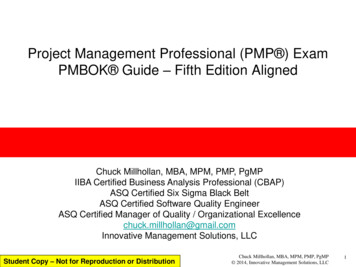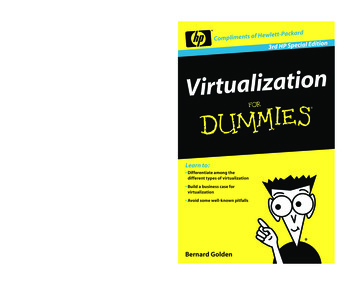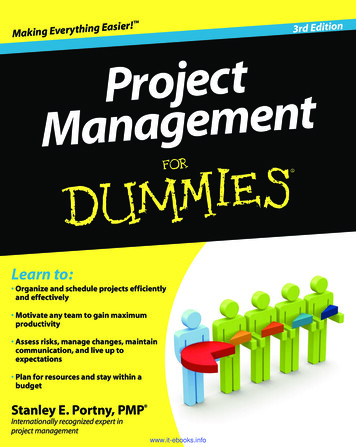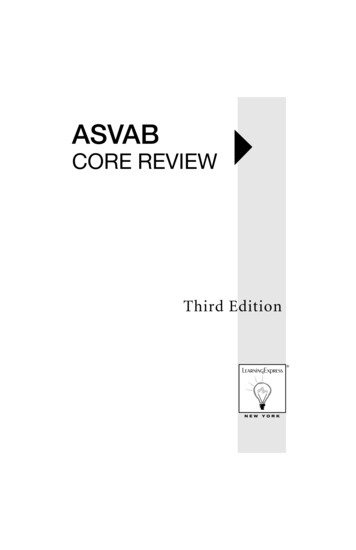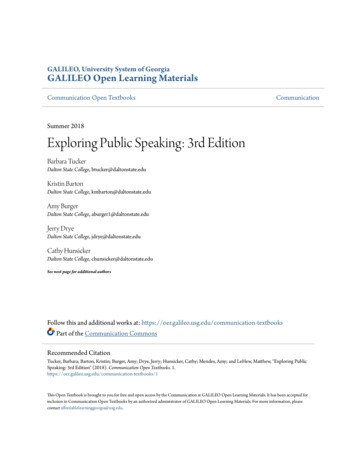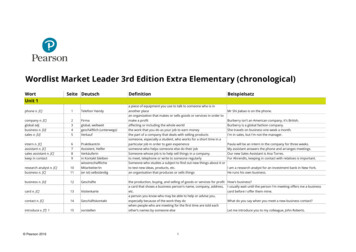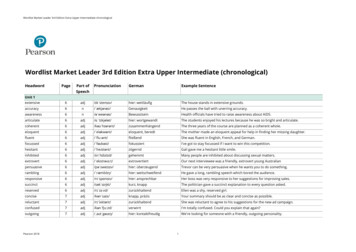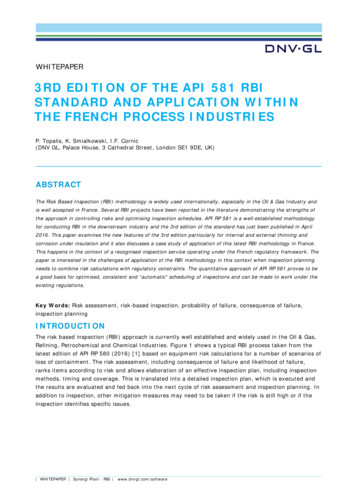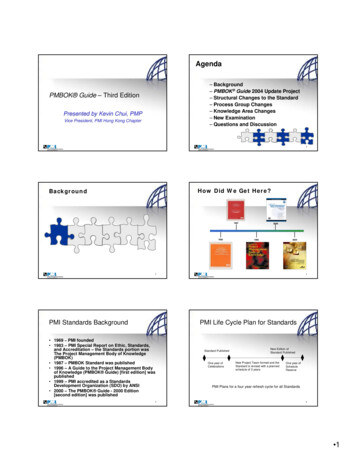
Transcription
Agenda– Background– PMBOK Guide 2004 Update Project– Structural Changes to the Standard– Process Group Changes– Knowledge Area Changes– New Examination– Questions and DiscussionPMBOK Guide – Third EditionPresented by Kevin Chui, PMPVice President, PMI Hong Kong Chapter2How Did We Get Here?Background198719832000199620043PMI Standards Background4PMI Life Cycle Plan for Standards 1969 – PMI founded 1983 – PMI Special Report on Ethic, Standards,and Accreditation – the Standards portion wasThe Project Management Body of Knowledge(PMBOK) 1987 – PMBOK Standard was published 1996 – A Guide to the Project Management Bodyof Knowledge (PMBOK Guide) [first edition] waspublished 1999 – PMI accredited as a StandardsDevelopment Organization (SDO) by ANSI 2000 – The PMBOK Guide - 2000 Edition[second edition] was published5Standard PublishedOne year ofCelebrationsNew Edition ofStandard PublishedNew Project Team formed and theStandard is revised with a plannedschedule of 3 yearsOne year ofScheduleReservePMI Plans for a four year refresh cycle for all Standards6 1
PMBOK 3rd EditionProject Volunteer FactsPMI’s Standards & Certification 266 total volunteers participated 19 countries covering all of the continents 98 (37%) volunteers were from outside theU.S.A. 52 industries were represent by allvolunteer’s 73 (28%) volunteers participated in aformal Preliminary Exposure Draftreview/survey Project team members Managing projects Specialists–––CAPM and PMBOK Guide – Third EditionPMP and PMBOK Guide – Third EditionPMBOK Guide – Third Edition and practice standards Managing programs Consultants helping organizations improve their pmmaturity Managing portfolios / strategic businessfocus–––Program Mgt. Standard in development & studying market needsfor certificationOPM3 and Ancillary Products & Services certifications (Q3’05)Portfolio Mgt. Standard in development7Structural Changes tothe Standard8PMBOK Guide 2004Overview of Major Changes No new Knowledge Areas Chapter 3 new and moved to a separate section Expanded description of Project ManagementIntegration – from three to seven processes Processes changed from 39 to 44– 5 new processes (7 added, 2 deleted)– 14 process name changes Inputs, Tools & Techniques and Outputs, are nowtightly integrated & consistently placed New Process Flow Diagrams added Expands and improves the Glossary and theIndex9Structural Changes to theTable of Contents2000 Edition SectionsMoved / MergedThird Edition Exposure Draft SectionsNew; Renamed / MovedSection IThe Project Management FrameworkChapters 1, 2, and 3Section IThe Project Management FrameworkChapters 1 and 2Chapter 1 Introduction Content Changes Clarifies differences between a project andoperations Areas of Expertise: Combines themanagement discussion with theapplication areas and soft skills into onesection Standard definitions of program andprogram management, portfolio andportfolio management More detailed discussion of PMOvariationsSection IIThe Standard for Project Management of a ProjectChapter 3Project Management Processes for a ProjectSection IIThe Project Management KnowledgeAreasChapters 4 through 12Section IIIThe Project Management Knowledge AreasChapters 4 through 12Section IIIAppendicesAppendix A through GSection IVAppendicesAppendix A through FSection IVGlossary and IndexSection VGlossary and Index101112 2
Process Groups ChangesChapter 2 Project Life Cycle andOrganization - Content Changes Clarifies distinction between project lifecycles and product life cycles Defines stakeholders in relation to theproject team Adds a discussion of the role of the PMOin organizations Introduces concept of a projectmanagement system Difference between Project Life Cycle andthe five Process Groups13Chapter 3 Project Management Processesfor a Project - Content Changes Describes requirement to address the fiveProcess Groups and their constituent processes Increases emphasis of Initiating Process Groupand Closing Process Group Increases emphasis on consolidated ProjectManagement Plan Adds Monitoring to the existing ControllingProcess Group Increases emphasis on Monitoring andControlling the project Includes new graphics for the five ProcessGroups14The Project ManagementProcess GroupsPlanProject managementintegration andprocess iterationoccurs throughout theprojectDoMonitoring &Controlling InitiatingProcessesExecutingProcesses15The Initiating Process Group2000 Edition InitiatingProcessesMoved / MergedInitiation (5.1)16The Planning Process GroupThird Edition InitiatingProcessesNew Processes;Renamed/Moved Processes2000 Edition Planning ProcessesMoved / Merged ProcessesThird Edition Planning ProcessesNew Processes; Renamed / MovedProcessesProject Plan Development (4.1)Develop Project Management Plan (4.3)Scope Planning (5.2)Scope Planning (5.1)Scope Definition (5.3)Scope Definition (5.2)Create WBS (5.3)Activity Definition (6.1)Activity Definition (6.1)Activity Sequencing (6.2)Activity Sequencing (6.2)Develop Project Charter (4.1)Resource Planning (7.1)Activity Resource Estimating (6.3)Activity Duration Estimating (6.3)Activity Duration Estimating (6.4)Develop Project ScopeStatement (4.2)Schedule Development (6.4)Schedule Development (6.5)Cost Estimating (7.2)Cost Estimating (7.1)Cost Budgeting (7.3)Cost Budgeting (7.2)1718 3
The Executing Process GroupThe Planning Process Group (continued)2000 Edition Planning ProcessesMoved / Merged ProcessesThird Edition Planning ProcessesNew Processes; Renamed / MovedProcesses2000 Edition ExecutingProcessesMoved / Merged ProcessesThird Edition Executing ProcessesNew Processes; Renamed / MovedProcessesQuality Planning (8.1)Quality Planning (8.1)Project Plan Execution (4.2)Organizational Planning (9.1)Human Resource Planning (9.1)Direct and Manage Project Execution(4.4)Quality Assurance (8.1)Perform Quality Assurance (8.2)Risk Management Planning (11.1) Risk Management Planning (11.1)Team Development (9.3)Develop Project Team (9.3)Risk Identification (11.2)Risk Identification (11.2)Information Distribution (10.2) Information Distribution (10.2)Qualitative Risk Analysis (11.3)Qualitative Risk Analysis (11.3)Quantitative Risk Analysis (11.4)Quantitative Risk Analysis (11.4)Staff Acquisition (9.2)Communications Planning (10.1)Communications Planning (10.1)Risk Response Planning (11.5)Risk Response Planning (11.5)Procurement Planning (12.1)Plan Purchases and Acquisitions (12.1)Solicitation Planning (12.2)Plan Contracting (12.2)Acquire Project Team (9.2)Manage Stakeholders (10.4)Solicitation (12.3)Request Sellers (12.3)Source Selection (12.4)Select Sellers (12.4)Contract Administration (12.5)19The Monitoring and Controlling ProcessGroup2000 Edition Controlling ProcessesMoved / Merged ProcessesThe Closing Process GroupThird Edition Monitoring and ControllingProcessesNew Processes; Renamed / MovedProcesses2000 Edition ClosingProcessesMoved / MergedProcessesMonitor and Control Project Work (4.5)Integrated Change Control (4.3)Integrated Change Control (4.6)Scope Verification (5.4)Scope Verification (5.4)Scope Change Control (5.5)Scope Control (5.5)Schedule Control (6.5)Schedule Control (6.6)Cost Control (7.4)Cost Control (7.3)Quality Control (8.3)Perform Quality Control (8.3)Performance Reporting (10.3)Risk Monitoring and Control (11.6)Risk Monitoring and Control (11.6)Third Edition ClosingProcessesNew Processes;Renamed/Moved ProcessesClose Project (4.7)Administrative Closure(10.4)Contract CloseoutContract Closure (12.6)(12.6)Manage Project Team (9.4)Performance Reporting (10.3)20Contract Administration (12.5)2122Knowledge Areas ChangesProcessGroupsProcess FlowDiagram2324 4
Chapter 4 - ProjectIntegration ManagementProcess ChangesOverview of Content Changes Removal of the concept “Core Processes”and “Facilitating Processes” Addition of several placeholders forrepresenting concepts, input/output, ortools/techniques – “OrganizationalProcess Assets”, “EnterpriseEnvironmental Factors”, “ProjectManagement Information System”,“Project Management Methodology”,“Project Management Plan”, “RiskRegister”2000 Edition ProcessesMoved / MergedProcesses4.1 Develop Project Charter4.2 Develop Preliminary Project ScopeStatement4.1 Project PlanDevelopment4.3 Develop Project Management Plan4.2 Project Plan Execution4.4 Direct and Manage Project Execution4.5 Monitor and Control Project Work4.3 Integrated ChangeControl4.6 Integrated Change Control4.7 Close Project25Chapter 4 - ProjectManagement IntegrationProcess ChangesThird Edition Exposure Draft ProcessesNew Processes; Renamed / MovedProcesses26Chapter 5Project Scope ManagementProcess Changes Enhances explanation of defined projectmanagement integration processes Provides description of integration fromthe aspect of the project managementprocess groups Provides clear description of integrationacross all project management processes Includes 4 new processes and 2 renamedprocesses all of which, have beensignificantly expand.2000 Edition ProcessesMoved / Merged ProcessesThird Edition ProcessesNew Processes; Renamed/MovedProcesses5.1 InitiationMoved to Project IntegrationManagement & renamed5.2 Scope Planning5.1 Scope Planning5.3 Scope Definition5.2 Scope Definition5.3 Create WBS5.4 Scope Verification5.4 Scope Verification5.5 Scope Change Control5.5 Scope Control27Chapter 5Project Scope ManagementContent Changes28Chapter 6Project Time ManagementProcess Changes Initiation is now in Chapter 4 and broken into two pieces. Scope Planning now refers to planning for scope management,not defining the detailed scope statement. Scope Definition now refers to defining the detailed projectscope statement, not creation of the WBS. A new process, Create WBS, is added. Scope Management Plan is expanded to cover planning forscope definition, create WBS, scope verification, and scopecontrol. It is now the output of scope planning.292000 Edition ProcessesMoved / MergedProcessesThird Edition ProcessesNew Processes; Renamed/MovedProcesses6.1 Activity Definition6.1 Activity Definition6.2 Activity Sequencing6.2 Activity Sequencing6.3 Activity Resource Estimating6.3 Activity DurationEstimating6.4 Activity Duration Estimating6.4 ScheduleDevelopment6.5 Schedule Development6.5 Schedule Control6.6 Schedule Control30 5
Chapter 6Project Time ManagementContent ChangesChapter 7Project Cost ManagementProcess Changes Moved “Activity Resource Estimating” into Chapter 6(6.3) Deleted PERT and the PERT figure Improved the PDM and ADM figures Dropped outdated figures: “Project Network Designwith Dates”; “Bar (Gantt) Chart; and “Milestone Chart” Added figure for Milestone Schedule, SummarySchedule, and Detailed Schedule Added “Critical Chain” to Tool & Technique reference2000 Edition ProcessesMoved / MergedProcessesThird Edition ProcessesNew Processes; Renamed/MovedProcesses7.1 Resource PlanningMoved to Project Time Management(Chapter 6)7.2 Cost Estimating7.1 Cost Estimating7.3 Cost Budgeting7.2 Cost Budgeting7.4 Cost Control7.3 Cost Control31Chapter 7Project Cost ManagementContent Changes32Chapter 8Project Quality ManagementProcess Changes Bottom- up cost estimating is focused on thework packages or individual activities Project budgeting is tied directly to the WBSas an aggregation of lower level components Project cost control now includes EarnedValue Management2000 Edition Processes Third Edition ProcessesMoved / MergedNew Processes; Renamed/MovedProcessesProcesses8.1 Quality Planning8.1 Quality Planning8.2 Quality Assurance8.2 Perform Quality Assurance8.3 Quality Control8.3 Perform Quality Control33Chapter 8Project Quality ManagementContent Changes34Chapter 9 - Project HumanResource ManagementProcess Changes The distinction between project qualityand product quality is strengthened Continuous Process Improvement isadded as an element of both PerformQuality Assurance and Perform QualityControl2000 Edition ProcessesThird Edition ProcessesDeleted/Moved Processes New Processes; Renamed/MovedProcesses9.1 OrganizationalPlanning9.1 Human Resource Planning9.2 Staff Acquisition9.2 Acquire Project Team9.3 Team Development9.3 Develop Project Team9.4 Manage Project Team3536 6
Chapter 9 - Project HumanResource ManagementContent ChangesChapter 10 - ProjectCommunications ManagementProcess Changes Manage Project Team added as a Controlling &Monitoring process Non-team stakeholder issues are now in Chapters 2 and10 Organizational chart and position description explanationsare expanded Tools & Techniques now include: networking, virtualteams, ground rules, conflict management, observationand conversation, project performance appraisals, issuelog2000 Edition ProcessesThird Edition ProcessesMoved / Merged Processes New Processes; Renamed/MovedProcesses10.1 CommunicationsPlanning10.1 Communications Planning10.2 InformationDistribution10.2 Information Distribution10.3 PerformanceReporting10.3 Performance Reporting10.4 Administrative ClosureIncorporated within Section 4.7,Close Project10.4 Manage Stakeholders37Chapter 10 - ProjectCommunications ManagementContent Changes38Chapter 11 - Project RiskManagementProcess Changes2000 Edition ProcessesMoved / Merged Processes Administrative Closure processinformation is merged into Chapter 4,Close Project process A new process, ManageStakeholders, is addedThird Edition ProcessesNew Processes; Renamed/MovedProcesses11.1 Risk ManagementPlanning11.1 Risk Management Planning11.2 Risk Identification11.2 Risk Identification11.3 Qualitative Risk Analysis11.3 Qualitative Risk Analysis11.4 Quantitative RiskAnalysis11.4 Quantitative Risk Analysis11.5 Risk Response Planning11.5 Risk Response Planning11.6 Risk Monitoring andControl11.6 Risk Monitoring and Control3940Chapter 12 ProjectProcurement Management Process ChangesChapter 11 - Project RiskManagementContent Changes2000 Edition ProcessesThird Edition ProcessesDeleted/Moved Processes New Processes; Renamed/MovedProcesses Increases focus on opportunities (v
The Project Management Body of Knowledge (PMBOK) 1987 – PMBOK Standard was published 1996 – A Guide to the Project Management Body of Knowledge (PMBOK Guide) [first edition] was published 1999 – PMI accredited as a Standards Development Organization (SDO) by ANSI 2000 – The PMBOK Guide - 2000 Edition [second edition] was published 6 PMI Life Cycle Plan for
